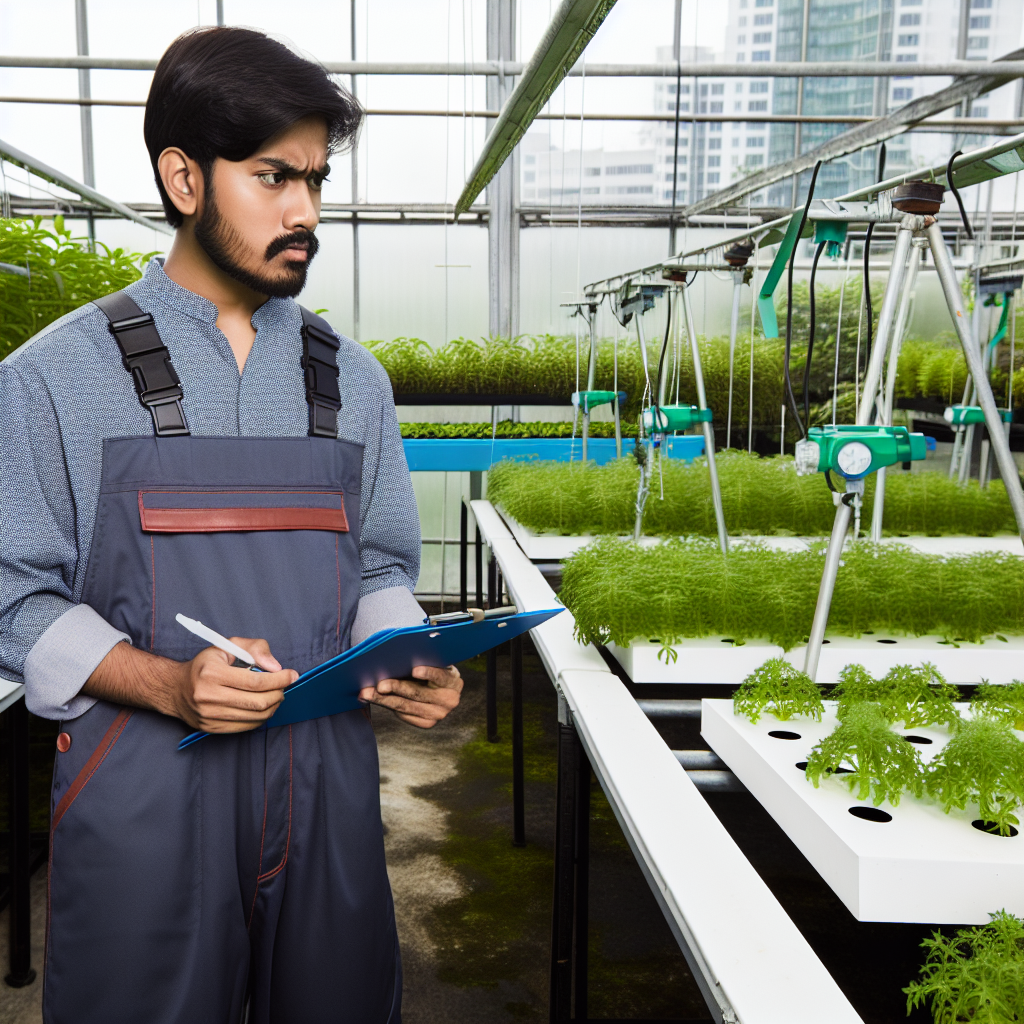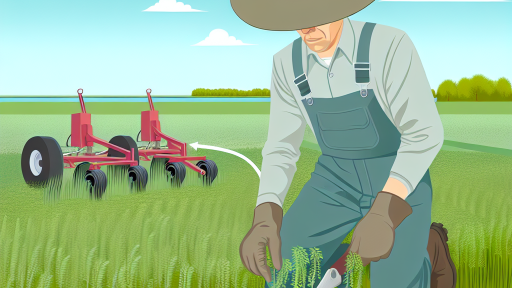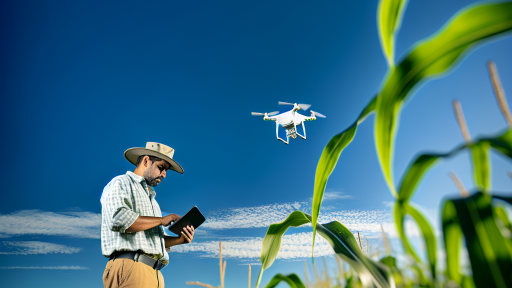Understanding Hydroponics: A Brief Overview
What is Hydroponics?
Hydroponics is a method of growing plants without soil.
Instead, it uses nutrient-rich water to provide essential minerals.
This technique allows for efficient water use and maximizes space.
Additionally, it minimizes the risks of soil-borne diseases.
Benefits of Hydroponic Systems
Hydroponics offers various advantages for modern agriculture.
- Improved growth rates lead to quicker harvests.
- Consistent environmental control enhances crop quality.
- Reduced need for pesticides promotes healthier produce.
Moreover, growers can produce crops year-round, regardless of climate.
Types of Hydroponic Systems
Several hydroponic systems cater to diverse gardening needs.
- Deep Water Culture (DWC) involves suspending plants in nutrient solutions.
- Nutrient Film Technique (NFT) circulates a thin film of nutrients over roots.
- Drip Systems provide nutrients directly to the plant roots.
Selecting the right system depends on available space and resources.
Hydroponics vs. Traditional Gardening
Hydroponics contrasts sharply with traditional soil gardening.
First, it requires less space and can be implemented vertically.
Second, it uses significantly less water than traditional methods.
Lastly, it often yields higher produce quality and quantity.
This innovation attracts many urban gardeners seeking sustainable solutions.
Types of Hydroponic Systems: An Introduction
Understanding Hydroponics
Hydroponics is the method of growing plants without soil.
Instead, it uses nutrient-rich water to support plant growth.
Transform Your Agribusiness
Unlock your farm's potential with expert advice tailored to your needs. Get actionable steps that drive real results.
Get StartedThis approach allows for efficient water use and faster growth rates.
Deep Water Culture
Deep water culture (DWC) is a popular hydroponic system.
It involves suspending plant roots in oxygenated nutrient solution.
This method promotes rapid growth due to constant nutrient availability.
Additionally, it requires minimal equipment and maintenance.
Nutrient Film Technique
Nutrient film technique (NFT) delivers nutrients through a thin film of water.
Plants grow in channels where the nutrient solution continuously flows.
This setup enhances oxygenation and nutrient uptake.
However, it demands careful monitoring to prevent dry roots.
Vertical Hydroponic Systems
Vertical hydroponics involves stacking plants to save space.
This method is ideal for urban settings where space is limited.
It maximizes light exposure, enhancing growth potential.
Furthermore, it can be integrated with aquaponics for diversified farming.
Wicking Systems
Wicking systems utilize capillary action to deliver nutrients.
They are simple and require no electricity, making them user-friendly.
This method is suitable for beginners and small-scale gardeners.
However, it may not support larger plants effectively.
Choosing the Right System
Selecting a hydroponic system depends on your specific needs.
Consider factors like available space, plant types, and budget.
Moreover, assess your technical skills for maintenance and setup.
Ultimately, the right choice enhances your gardening experience.
Evaluating Space Requirements for Hydroponic Setup
Understanding Available Space
Begin by assessing the area where you plan to install the hydroponic system.
Consider both indoor and outdoor spaces for potential setups.
Measure the length, width, and height of the available space.
Showcase Your Farming Business
Publish your professional farming services profile on our blog for a one-time fee of $200 and reach a dedicated audience of farmers and agribusiness owners.
Publish Your ProfileAlso, note any structural elements, such as windows or doors, that could affect placement.
Choosing the Right Type of Hydroponic System
Select a hydroponic system that fits within your available space.
Various systems, such as NFT or deep water culture, require different setups.
Vertical systems can maximize space efficiency in tight areas.
Additionally, modular systems allow for scalability as your needs grow.
Considering Light Requirements
Ensure your chosen space has adequate light for plant growth.
Natural sunlight is ideal but may not always be available.
When using artificial lights, account for their placement and power needs.
Position lighting to avoid shadows that could hinder plant growth.
Accessing Utilities
Identify the nearest sources of water and electricity.
Hydroponic systems need proper water supply and drainage.
Ensure electrical outlets are safely located for running pumps and lights.
Plan for easy access to utilities to maintain the system effectively.
Environmental Considerations
Assess the temperature and humidity levels of your chosen location.
Insulate your space if necessary to maintain optimal conditions.
Control humidity to prevent mold growth and pest issues.
Consider ventilation options to ensure proper airflow around the plants.
Future Planning
Think about future expansion when choosing your space.
Leave room for adding new systems or plant varieties as desired.
Flexibility can help adapt to changing interests or markets.
Finally, regularly reassess your space needs as your hydroponic journey progresses.
Explore Further: How to Boost Soil Fertility Naturally on Farms
Choosing the Right Nutrient Solution
Understanding Nutrient Solutions
Nutrient solutions are essential for hydroponic systems.
They supply all the necessary elements for plant growth.
Hydroponics relies on precise nutrient delivery.
Using the right solution promotes healthy plants.
Key Nutrients for Plant Growth
Plants require macronutrients for growth.
These include nitrogen, phosphorus, and potassium.
Micronutrients also play critical roles.
Examples are iron, manganese, and zinc.
Types of Nutrient Solutions
Water-soluble fertilizers are common in hydroponics.
A balanced solution supports all plant stages.
Some growers prefer organic nutrient solutions.
Organic options promote soil health and biodiversity.
Liquid Nutrient Solutions
These are ready to use and easy to apply.
Liquid nutrients dissolve quickly in water.
They are suitable for various hydroponic systems.
Powdered Nutrient Solutions
Powdered nutrients require mixing with water.
They often have a longer shelf life.
Many growers choose this option for cost-effectiveness.
Showcase Your Farming Business
Publish your professional farming services profile on our blog for a one-time fee of $200 and reach a dedicated audience of farmers and agribusiness owners.
Publish Your ProfileConsidering pH Levels
Maintaining the correct pH is crucial.
Most plants thrive between pH 5.5 and 6.5.
Check nutrient solutions regularly for pH balance.
Choosing the Right Brand
Not all nutrient brands are created equal.
Researching brand reputation is essential.
Read user reviews and consider recommendations.
Customizing Your Nutrient Solution
Your choice may depend on the plant type.
Some plants have specific nutrient requirements.
Adjusting the solution can improve yield and quality.
Experimenting may lead to better results.
Uncover the Details: Integrating AI Solutions In Crop Analytics
Assessing Budget and Cost
Understanding Initial Setup Costs
Starting a hydroponic garden requires an upfront investment.
The type of system selected greatly influences costs.
For instance, a simple nutrient film technique costs less than a vertical system.
Consider purchasing seeds, grow lights, and reservoirs as essentials.
Gather quotes from various suppliers to compare prices.
Moreover, investing in quality equipment may save you money in the long run.
Evaluating Ongoing Maintenance Expenses
Hydroponic systems demand regular maintenance for optimal performance.
Funds will be needed for nutrient solutions and pH testing supplies.
Plan for the cost of electricity, especially for grow lights.
Additionally, you might require tools for pruning and other tasks.
Keeping spare parts on hand can prevent costly emergencies later.
Setting a Realistic Budget
Establish a comprehensive budget to evaluate your financial capacity.
Think about both initial and recurring costs.
This action helps in making informed decisions.
Calculate potential yields to understand your return on investment.
Furthermore, research potential grants or subsidies for hydroponic projects.
Finding Cost-Effective Solutions
Look for used equipment to reduce initial expenses.
Online marketplaces often have valuable deals on hydroponic supplies.
Joining local gardening clubs may offer access to shared resources.
Consider DIY techniques for constructing parts of the system.
Networking with other growers can provide insights into savings opportunities.
Gain More Insights: Crop Protection Strategies Through Disease Forecasting
Selecting Plant Types Suited for Hydroponic Systems
Understanding Plant Compatibility
Not all plants thrive in hydroponic systems.
Understanding which types work best can greatly enhance your success.
First, consider leafy greens as a prime option.
Plants like lettuce and spinach adapt well to hydroponic conditions.
They grow fast and require minimal space.
Additionally, herbs such as basil and cilantro flourish in hydroponics.
These plants often yield fragrant and flavorful results.
Showcase Your Farming Business
Publish your professional farming services profile on our blog for a one-time fee of $200 and reach a dedicated audience of farmers and agribusiness owners.
Publish Your ProfileFruit-bearing plants can also be good choices.
Tomatoes and strawberries produce successfully in hydroponic setups.
However, they may need more attention and support.
Determining Growth Requirements
Each plant type has unique growth needs.
Identifying these requirements is vital.
Consider factors such as light, nutrients, and water needs.
Lettuce thrives under low light and prefers cooler temperatures.
On the other hand, tomatoes require more light and warmer conditions.
Researching these specific needs allows for better planning.
Assessing Space and Resources
Your available space plays a crucial role.
Vertical systems work well in limited spaces.
This setup allows for increased plant variety.
Monitor your available resources, such as nutrients and water.
More demanding plants can strain your resources.
Choose plants that align with what you can provide.
Testing Plant Varieties
Start with smaller crops to test your setup.
Growing a few varieties helps you understand their needs.
Keep detailed records of their growth habits.
This data can guide your future plant selections.
As you gain experience, expand your variety.
This process fosters a successful hydroponic environment.
Delve into the Subject: Climate Control for Aquaponic Operations

The Importance of Lighting: Natural vs. Artificial Options
Understanding the Role of Light in Plant Growth
Light plays a critical role in the photosynthesis process.
It helps plants produce energy from sunlight.
Without adequate lighting, plants may fail to thrive.
Natural Lighting: A Cost-Effective Choice
Natural sunlight is the most economical lighting source for plants.
It provides a broad spectrum of wavelengths needed for growth.
Using natural light can reduce electricity costs significantly.
However, it may be inconsistent depending on the weather and season.
Challenges of Relying on Natural Light
Seasonal changes can affect light availability.
During winter, shorter days mean less natural light.
In addition, cloud cover can limit sunlight penetration.
This may lead to slower plant development.
Artificial Lighting: Overcoming Natural Limitations
Artificial lights can provide a consistent light source year-round.
They allow for precise control over light intensity and duration.
Various types of grow lights are available, including LEDs and fluorescent lights.
Investing in artificial lighting can maximize growth potential.
Comparing Different Types of Artificial Lights
- LED Lights: Energy-efficient and long-lasting.
- Fluorescent Lights: Affordable with a good light spectrum.
- High-Intensity Discharge Lights: Excellent for larger setups but consume more energy.
Each type of light has its advantages and limitations.
Choosing the right one depends on the specific needs of your plants.
Combining Natural and Artificial Lighting
Many growers benefit from a combination of both lighting sources.
Showcase Your Farming Business
Publish your professional farming services profile on our blog for a one-time fee of $200 and reach a dedicated audience of farmers and agribusiness owners.
Publish Your ProfileThis hybrid approach maximizes plant growth efficiency.
Using artificial lights to supplement natural light can be effective.
Timing the artificial lights can help extend the photoperiod.
Making the Best Choice for Your Setup
Your choice between natural and artificial lighting will depend on several factors.
Consider your budget, plant types, and growing environment.
Ultimately, the right lighting setup can significantly influence plant health.
Investing time in research will pay off in better yields.
Setting Up a Controlled Environment: Temperature and Humidity Management
Importance of Temperature Regulation
Managing temperature is crucial for optimal plant growth.
Plants thrive within specific temperature ranges.
Excessive heat can lead to stress and reduced yields.
Conversely, low temperatures can stunt growth significantly.
Tools for Temperature Control
Utilizing thermostats can greatly enhance temperature management.
Heaters and fans are essential tools for controlling temperature fluctuations.
Consider using digital temperature monitors for accurate readings.
Humidity Management Techniques
Maintaining adequate humidity levels is equally important.
High humidity can promote mold and disease.
Conversely, low humidity can lead to dehydration in plants.
Methods for Humidity Control
- Use humidifiers in dry conditions.
- Employ dehumidifiers to combat excess moisture.
- Ventilation systems can help regulate humidity levels efficiently.
Monitoring Environmental Conditions
Regularly monitor both temperature and humidity levels.
This practice ensures a stable environment for your plants.
Investing in sensor technology can automate these checks.
Creating a Balanced Environment
Finding the right balance between temperature and humidity is key.
This balance enhances overall plant health and productivity.
Adjustments may be necessary throughout the growth cycle.
Common Mistakes to Avoid When Choosing a Hydroponic System
Neglecting Space Requirements
Many beginners overlook the space their hydroponic setup will occupy.
Ensure you measure your available area before selecting a system.
Consider vertical systems if space is limited.
Ignoring System Type Compatibility
Each plant has specific growing needs that vary by hydroponic system.
Be sure to research which system matches your chosen plants.
Avoid choosing a system solely based on popularity without considering compatibility.
Underestimating Budget Constraints
Hydroponic systems can range widely in cost, from inexpensive to high-end options.
First, set a realistic budget for your project.
Then, factor in additional expenses such as nutrient solutions and maintenance tools.
Overlooking Light Requirements
Plants in a hydroponic setup require adequate lighting for optimal growth.
Many beginners fail to plan for correct light placement.
Choose an appropriate lighting system suited to your plant types and space.
Forgetting Maintenance Needs
Every hydroponic system requires some level of maintenance.
It’s important to understand the time commitment involved.
Regularly check nutrient levels and water conditions for healthy growth.
Skipping Research on Nutrients
Hydroponic plants depend on nutrient solutions for growth.
New growers often underestimate the importance of balanced nutrients.
Showcase Your Farming Business
Publish your professional farming services profile on our blog for a one-time fee of $200 and reach a dedicated audience of farmers and agribusiness owners.
Publish Your ProfileConduct thorough research to select the right nutrient formulations for your plants.
Disregarding Pest Management
Pest management is crucial, even in a controlled environment like hydroponics.
Be proactive in implementing pest control strategies from the start.
Regularly inspect plants for any signs of pests or diseases.
Not Joining a Community
A supportive community can provide valuable insights and support.
Connect with other hydroponic growers to exchange advice and experiences.
Online forums and local gardening clubs can be excellent resources.
Sourcing Quality Equipment
Choosing the Right Brands
Investing in quality equipment starts with selecting reputable brands.
Look for brands that specialize in hydroponic systems.
Companies like AeroGarden and General Hydroponics offer reliable products.
You can also explore brands like Hydrofarm and Current Culture.
Research customer reviews to gauge product quality.
Choosing trustworthy brands ensures durability and performance.
Finding Reliable Suppliers
Your equipment quality also depends on where you buy it.
Consider purchasing from established hydroponic suppliers.
Local gardening centers often carry quality hydroponic systems.
Online retailers like Amazon and eBay provide a wide selection.
Seek suppliers that offer warranties and customer support.
Assessing Equipment Specifications
Evaluate equipment specifications carefully before making a purchase.
Understand the requirements for your hydroponic system.
Pay attention to lighting, nutrient systems, and growing mediums.
Some systems require specific levels of pH and temperature.
Choose equipment that is appropriate for your setup scale.
Budgeting for Your Equipment
Start by setting a budget for your hydroponic project.
Quality equipment can vary significantly in price.
Balance cost with the quality and longevity of the products.
Consider investing in a few high-quality pieces rather than many low-cost ones.
Look for package deals that might save you money.
Considering Maintenance and Support
Choose equipment that is easy to maintain.
Look for suppliers that provide excellent customer support.
Review warranty policies to ensure any defects are covered.
Additionally, find out about available repair services.
Reliable support makes a significant difference in your hydroponic journey.




